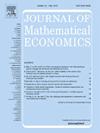A scalable Bayesian persuasion framework for epidemic containment on heterogeneous networks
IF 0.7
4区 经济学
Q3 ECONOMICS
引用次数: 0
Abstract
During an epidemic, the information available to individuals in the society deeply influences their belief of the true infectiousness of the disease, and thereby the preventive measures they take to stay safe from the infection. In this paper, we develop a scalable framework for ascertaining the optimal choice of the test for determining the infectiousness of the disease whose results must be truthfully communicated to individuals for the purpose of epidemic containment. We use a networked public goods model to capture the underlying societal structure and the individuals’ incentives during an epidemic, and the Bayesian persuasion framework for modelling the choice of the test. Our first main result is a structural decomposition of the government’s objectives into two independent components – a component dependent on the utility function of individuals, and another dependent on properties of the underlying network. Since the network dependent term in this decomposition is unaffected by the testing strategies adopted by the government, this characterization simplifies the problem of finding the optimal testing methodology. We find explicit conditions, in terms of certain concavity measures, under which perfectly accurate tests, uninformative tests, tests which exaggerate the infectiousness, and ones which downplay it are optimal. Furthermore, we explicitly evaluate these optimal tests for exponential and quadratic benefit functions and study their dependence on underlying parameter values. The structural decomposition results are also helpful in studying other forms of interventions like incentive design and network design.
异构网络流行病控制的可扩展贝叶斯说服框架
在流行病期间,社会中个人可获得的信息会深刻影响他们对疾病真正传染性的信念,从而影响他们为避免感染而采取的预防措施。在本文中,我们开发了一个可扩展的框架,用于确定确定疾病传染性的测试的最佳选择,其结果必须如实传达给个人,以实现流行病控制。我们使用网络公共物品模型来捕捉流行病期间潜在的社会结构和个人动机,并使用贝叶斯说服框架来模拟测试的选择。我们的第一个主要结果是将政府目标结构分解为两个独立的组成部分——一个依赖于个人的效用函数,另一个依赖于底层网络的属性。由于该分解中的网络依赖项不受政府采用的测试策略的影响,因此该表征简化了寻找最佳测试方法的问题。我们找到了明确的条件,就某些凹度测量而言,在这些条件下,完全准确的测试、无信息的测试、夸大传染性的测试和淡化传染性的测试是最佳的。此外,我们明确地评估了指数和二次效益函数的最优检验,并研究了它们与底层参数值的依赖关系。结构分解结果对激励设计、网络设计等其他干预形式的研究也有一定的参考价值。
本文章由计算机程序翻译,如有差异,请以英文原文为准。
求助全文
约1分钟内获得全文
求助全文
来源期刊

Journal of Mathematical Economics
管理科学-数学跨学科应用
CiteScore
1.70
自引率
7.70%
发文量
73
审稿时长
12.5 weeks
期刊介绍:
The primary objective of the Journal is to provide a forum for work in economic theory which expresses economic ideas using formal mathematical reasoning. For work to add to this primary objective, it is not sufficient that the mathematical reasoning be new and correct. The work must have real economic content. The economic ideas must be interesting and important. These ideas may pertain to any field of economics or any school of economic thought.
 求助内容:
求助内容: 应助结果提醒方式:
应助结果提醒方式:


